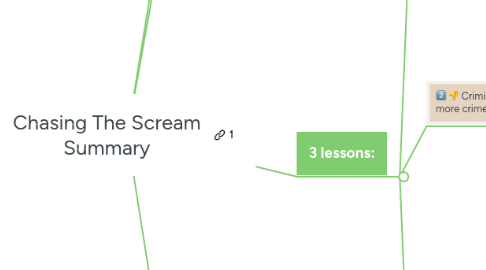
1. 1-Sentence-Summary:
1.1. Chasing The Scream is a scathing review of the failed war on drugs, explaining its history with surprising statistics and identifying new ways that we can think about addiction, recovery, and drug laws.
2. Favorite quote from the author:
2.1. "The opposite of addiction isn't sobriety. It's connection." - Johann Hari
3. 3 lessons:
3.1. The US started the war on drugs during WWI and proponents used it as a way to push racism.
3.1.1. At the beginning of the twentieth century, drugs we now consider illicit were widely used and sold at places like department stores.
3.1.2. The crackdown came in 1914 when the US started prohibiting the sale of drugs.
3.1.3. It was the outbreak of WWI, and the US was becoming rapidly industrialized.
3.1.4. There was a lot of anxiety about this changing world.
3.1.4.1. One way people felt they could control this, rather than focusing on class tensions or other less tangible problems, was to prohibit drugs.
3.1.5. The primary proponent, Harry Anslinger, cracked down zealously as the first officer of the US Bureau of Narcotics.
3.1.5.1. But when he noticed they still flowed freely in, he suspected communists were selling them to undermine him.
3.1.5.2. He used his position to help convince other countries to crack down too.
3.1.6. More recent campaigns have worked to convince us the war on drugs was for noble reasons, like helping addicts.
3.1.6.1. But in 1914, proponents really just saw it as a way to suppress minorities.
3.1.6.1.1. Harry Anslinger made claims in interviews that the increase in drug use was entirely among blacks.
3.1.6.1.2. He and others pushed the idea it was a black problem.
3.1.6.1.3. Through this, they were able to tap into people’s prejudices and fear of minorities to garner support for fighting drugs.
3.2. Criminalizing drugs has just made way for more crimes and violence.
3.2.1. When Anslinger started their crusade to ban drugs, they thought they would slowly disappear from the streets.
3.2.2. But as it turns out, criminalizing a product doesn’t make it disappear. People instead find ways to get it illegally
3.2.2.1. This is especially true with drugs because addiction drives people to try to find a way to get their fix at any cost.
3.2.2.2. This is why the biggest legacy of drug criminalization has been the creation of criminal networks controlling the distribution of illegal drugs.
3.2.2.3. And it’s been extremely profitable for them.
3.2.2.3.1. Before the criminalization of morphine, it only cost a few cents per grain.
3.2.2.3.2. After, drug dealers charged a dollar for the same amount.
3.2.2.3.3. Addicts were forced to pay the higher cost because of their addiction left them no other choice.
3.2.3. Because drugs became more expensive, it also meant addicts had to start committing small crimes to pay for their addiction.
3.2.3.1. What we now think of as junkie who spends their days stealing and prostituting is a product of the war on drugs.
3.2.3.2. Cheap, legal drugs allowed addicts to live somewhat normal lives, but after their criminalization, they started quitting jobs and obligations so they could support the addiction.
3.2.4. It also has increased violence because of the risky nature of drug dealing.
3.2.4.1. Because they can’t turn to law enforcement, gangs must have a violent reputation to make potential robbers afraid to mess with them.
3.2.4.2. When law enforcement takes out dealers in the chain, another dealer quickly replaces them.
3.3. Addicts are misunderstood, and criminalizing drugs has made it hard for them to get support.
3.3.1. The war on drugs has also given us many misconceptions about addiction.
3.3.1.1. We think using drugs leads to addiction, but this might not be the case.
3.3.2. You probably know someone who had surgery and was prescribed opiates to help the pain for a while.
3.3.2.1. Did they develop an addiction?
3.3.2.2. If just taking a drug consistently meant addiction, wouldn’t hospitals have tons of post-surgery addicts?
3.3.3. A study in the Canadian Journal of Medicine showed patients who were significantly exposed to opiates weren’t more likely to become addicted to them than anyone else.
3.3.4. Addiction is actually a combination of substances that are potentially addictive and individuals who are addiction-prone.
3.3.4.1. Many people’s susceptibility seems to come from childhood trauma.
3.3.4.1.1. Two-thirds of drug users had some sort of trauma in their past such as abuse of any kind or death of a parent
3.3.4.2. People are also susceptible if they are lonely or have lost connection with others.
3.3.4.3. Addiction becomes a surrogate for human bonds that helps people forget.
3.3.5. It’s time to decriminalize drug possession.
3.3.5.1. This would not only help the stigma of addiction but also let addicts get the help they desperately need.
3.3.5.2. If they aren’t afraid of being arrested for admitting drug use, people are more likely to be honest about drug history.
3.3.5.3. This way authorities could help them get resources.
3.3.5.4. It would also help authorities see them as humans who need help rather than criminals.
